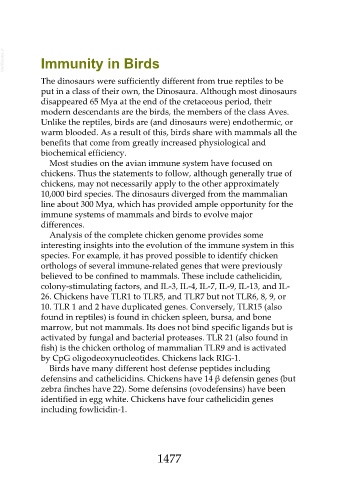Page 1477 - Veterinary Immunology, 10th Edition
P. 1477
VetBooks.ir Immunity in Birds
The dinosaurs were sufficiently different from true reptiles to be
put in a class of their own, the Dinosaura. Although most dinosaurs
disappeared 65 Mya at the end of the cretaceous period, their
modern descendants are the birds, the members of the class Aves.
Unlike the reptiles, birds are (and dinosaurs were) endothermic, or
warm blooded. As a result of this, birds share with mammals all the
benefits that come from greatly increased physiological and
biochemical efficiency.
Most studies on the avian immune system have focused on
chickens. Thus the statements to follow, although generally true of
chickens, may not necessarily apply to the other approximately
10,000 bird species. The dinosaurs diverged from the mammalian
line about 300 Mya, which has provided ample opportunity for the
immune systems of mammals and birds to evolve major
differences.
Analysis of the complete chicken genome provides some
interesting insights into the evolution of the immune system in this
species. For example, it has proved possible to identify chicken
orthologs of several immune-related genes that were previously
believed to be confined to mammals. These include cathelicidin,
colony-stimulating factors, and IL-3, IL-4, IL-7, IL-9, IL-13, and IL-
26. Chickens have TLR1 to TLR5, and TLR7 but not TLR6, 8, 9, or
10. TLR 1 and 2 have duplicated genes. Conversely, TLR15 (also
found in reptiles) is found in chicken spleen, bursa, and bone
marrow, but not mammals. Its does not bind specific ligands but is
activated by fungal and bacterial proteases. TLR 21 (also found in
fish) is the chicken ortholog of mammalian TLR9 and is activated
by CpG oligodeoxynucleotides. Chickens lack RIG-1.
Birds have many different host defense peptides including
defensins and cathelicidins. Chickens have 14 β defensin genes (but
zebra finches have 22). Some defensins (ovodefensins) have been
identified in egg white. Chickens have four cathelicidin genes
including fowlicidin-1.
1477

